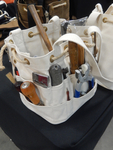We may receive a commission when you use our affiliate links. However, this does not impact our recommendations.

The aerosol on the left sprays a cone-shaped pattern. The one on the right sprays an oval-shaped pattern and can be changed from horizontal to vertical and back by rotating the nozzle.
After my last post (April 10) about wearing gloves when spraying with a spray gun, I thought it might be appropriate to discuss aerosols as a substitute for spray guns.
There are two types of aerosols, each identifiable by its nozzle. The nozzle on most aerosols has a cylindrical-shaped actuator you push down to spray a cone-shaped pattern. The nozzle on some aerosols has a small button at the top of the actuator that depresses a pin and a tiny rectangular disk on the front that you can rotate, usually with the aid of pliers, to change a fan pattern from vertical to horizontal or visa versa. These aerosols lay down a more even coating. Inexpensive trigger handles are widely available for both types to reduce finger cramping.

Inexpensive handles are available from most suppliers of aerosols.
With both types, you need to shake the can before using. If the can contains solids, such as pigment or flatting agent, it will have a ball you’ll hear knocking against the sides as you shake. This ball helps put the solids into suspension. If you don’t hear the ball, continue shaking until you do, then shake for another 10 to 20 seconds. When finished spraying, clean the diptube and valve by turning the can upside down and spraying until no more liquid comes out. If you don’t do this, you risk the finish in the passageway drying, which may make the aerosol unusable in the future.

To clean the tube and nozzle hold the aerosol upside down and spray until no more material comes out.
Most popular finishes are packaged in aerosols in sheens ranging from gloss to flat. These include polyurethane, shellac, water-based finish, lacquer and pre-catalyzed lacquer. Other useful products available in aerosols include sanding sealers, toners, shading stains and blush removers, which are very slow evaporating lacquer solvents used to remove white water rings on lacquer surfaces.
The finishes in aerosols are the same as those used in spray guns, only thinned more to fit easily through the small hole in the nozzle. You normally have to spray at least twice the number of coats to get the same film build you achieve with a spray gun.
Aerosols have the same application advantages as spray guns when compared to brushes: speed and a more level surface. To spray a fully wet coat that’s not so wet it runs, arrange the workpiece and a light source so you can see a reflection in the area you’re spraying; then adjust your speed and distance. Watch that you don’t partially cover the hole in the nozzle with your finger, as this causes sputtering. Be conscious, also, that the solvents included in many aerosols can cause some older finishes to blister. Spraying thinner mist coats will help avoid this.
So what about wearing gloves while spraying with an aerosol to keep the finish from getting on your finger? If the gloves fit tightly on your index finger, this may work. But if the gloves are loose fitting, there’s a greater likelihood the index finger of the gloves may droop down and disrupt the spray pattern. Personally, it doesn’t bother me to get a little finish on the tip of my finger, and I feel like I have more control and get better results.
– Bob Flexner
Here are some supplies and tools we find essential in our everyday work around the shop. We may receive a commission from sales referred by our links; however, we have carefully selected these products for their usefulness and quality.








